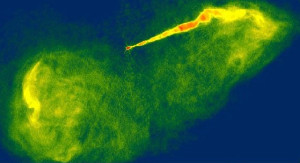Science Seen Physicist and Time One author Colin Gillespie helps you understand your world.
Go Jets Go!
How about those jets! Jets in space are hot in science news these days. They are hot because they are a huge problem. How huge? Try thinking of a billion times a billion miles.
Let’s start small. Archerfish find breakfast using water jets. Their jets are longer than their body size. How they shoot their jets at bugs is easy to discern: Point tongue, purse lips and squirt.
Black holes shoot jets too. Until the 1990s, black holes were just an awkward mix of fiction and Penrose-and-Hawking math. Like archerfish black holes are hard to find. But now astronomers are finding many of them.
They find big black holes at the centers of giant galaxies. Each holds matter equal to millions or even billions of Suns. Gravity crushes all that matter to a tiny point. Physics figures out the black hole’s mass from measurements of stars that whip around at stunning speeds nearby. Nothing that comes near it (inside its ‘event horizon’) can escape, not even light. Yet from nearby it blasts a millions-of-light-years-long jet into space. Not bad for an object that is billions of times smaller than its jet. This is the most extraordinary spectacle in the universe. Its prosaic name is Active Galactic Nucleus or AGN. How it shoots its jet is the subject of wild speculation.
Let’s be clear about the problem: The inconceivably vast jet is heading away from the most ferocious pull in the universe. And  it moves at near- (or some say much greater-than-) light-speed with a violence that can reshape its entire galaxy. Compared to this energy, a quadrillion atom bombs every microsecond is not even a mosquito bite. How can this be? As American astrophysicist Dr. Monica Young, who is Sky and Telescope’s web editor, said recently:
it moves at near- (or some say much greater-than-) light-speed with a violence that can reshape its entire galaxy. Compared to this energy, a quadrillion atom bombs every microsecond is not even a mosquito bite. How can this be? As American astrophysicist Dr. Monica Young, who is Sky and Telescope’s web editor, said recently:
Start asking some basic questions about jets and you’ll find mass confusion. How do jets form? What accelerates the flow? What is the flow?
Astrophysicists are not just confused; they are amazed. These jets show up from more than half way across the visible universe. Astronomers see strings of giant things that they call ‘cannon balls’ moving at ten times the speed of light. The current explanation is the jets are made of ordinary molecules of gas like hydrogen; and the engines driving them consist of particles blasting away from the black hole at almost the speed of light. The hottest news may be the jets are not so hot. British astrophysicist Clive Tadhunter says:
Much of the gas in the outflows is in the form of molecular hydrogen, which is fragile in the sense that it is destroyed at relatively low energies. I find it extraordinary that the molecular gas can survive being accelerated by jets of highly energetic particles moving at close to the speed of light.
The theory of jets is a patchwork of Band-Aids. It says the engine’s energy comes from the ‘accretion disk’ of a rotating black hole (a donut of hot matter swirling round and ultimately falling in). A few weeks ago, American physicist Robert Antonucci reviewed five decades of studies of AGNs. He says accretion-disk models are inconsistent with the data. Indeed he says the whole field is a mess:
Many theory papers have already been ruled out by observations by the time they are published. Observers routinely use models to interpret their data long after the models have been falsified. … We aren’t even close to having the correct physics.
Ta-dah! No, not the Scissor Sisters album; last week I said, ‘Physics has now all but lost experimental contact with the real world.’ But not in the realm of jets! It may be a mess, but AGN-astronomy is confronting crumbling physics with astounding observations. Look for new ideas to arise from AGNs.
Sources
Monica Young (2014), “A MAD new way to make black hole jets”, Sky & Telescope, Cambridge MA: Sky & Telescope Media, June 12, http://www.skyandtelescope.com/astronomy-news/new-way-make-black-hole-jets/
Clive Tadhunter et al (2014), “Jet acceleration of the fast molecular outflows in the Seyfert galaxy IC 5063”, Nature, London: Macmillan Publishers Limited, vol. 511, p. 440; http://www.nature.com/nature/journal/v511/n7510/abs/nature13520.html
Robert Antonucci (2105), “Active Galactic Nuclei and Quasars: Why Still a Puzzle after 50 Years?”, arXiv, Cornell University Library, http://arxiv.org/abs/1501.02001
Image sources:
Kim Taylor; see Simon Tomlinson (2012), “Bullseye! Deadly accurate archer fish takes out prey with powerful jet of water from below the surface”, Mail Online, London: The Daily Mail, October 22; http://www.dailymail.co.uk/sciencetech/article-2221324/Archer-fish-fires-powerful-arrow-water-knock-bug-leaf.html
NASA (1999), National Radio Astronomy Observatory, Hubblesite, http://imgsrc.hubblesite.org/hu/db/1999/43/images/b/formats/full_jpg.jpg

No comments yet.